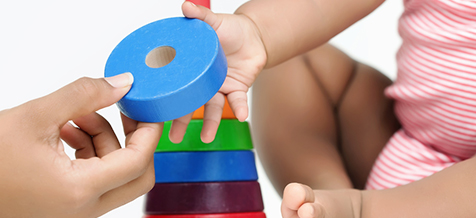Activities to Support Your Baby’s Motor Skill Development
While the movements your baby exhibits in the first few months of his life are fast and sudden actions, these movements are replaced by softer, more voluntary movements as the nervous system and muscle control begin to synchronize. With simple activities and practices, you can help your baby strengthen muscle development and motor skills.
What are your baby’s motor skills?
Improving gross motor skills involves the major muscle groups your baby uses to sit, stand, walk, run, maintain balance or change positions. Fine motor skills include using their hands to eat, draw, play, or pick up small objects.
Your baby’s motor skill development at 1 year old
During the first 3 months, your baby’s muscles are not sufficiently developed; therefore you need to support the head and neck. At 4 months old, your baby has the muscle control he needs to turn his head and watch objects. The ability to balance, sit, crawl, and eventually stand normally develops within the first 12 months. Your baby’s fine motor skills progress from awkwardly bending over objects to being able to grasp objects properly in the first few months.
How do you support your baby’s motor skill development?
During the first months and under your close supervision, lay your baby on his tummy to develop neck and back muscles. Hold a colorful toy and make an engaging sound to get your baby’s attention. Always keep your “belly time” short – a minute or two will suffice.
Roll a large ball towards your baby. This allows you to interact with your baby and observe his developing skills. Initially, your baby will hit the ball back but will eventually learn to hit the ball to send it where you are.
Put an object (like a rattle) in your baby’s hand and pull it very lightly. This activity helps your baby develop muscles by resisting your effort.
Stack the blocks. Nothing motivates a baby to crawl more than a tower of blocks he can’t reach and awaiting collapse.
Around the fourth to 7th month, slowly pull your baby into a standing position. A 7-month-old baby will begin to understand the function of every part of his body and will begin to use his feet and legs to hop up and down with your help. This will help prepare your baby for walking in the future. For younger babies, you can do this activity using the supported sitting position.
Place obstacles in front of you. Place light seat cushions, pillows or boxes on the carpet. Invite your moving baby to crawl on or between them. You can even hide behind an obstacle and play ce-ee. Never take your eyes off your baby while playing with pillows.
Use finger foods for fine motor training. Make every eating experience a fun time for learning and practice when you start adding healthy snacks to your baby’s diet during the final months of your baby’s first year (and with your pediatrician’s approval). Encourage your baby to take appropriately sized bites of fruit, cereal, or vegetables whenever possible. Show how to do it and say well done with every successful snack.
